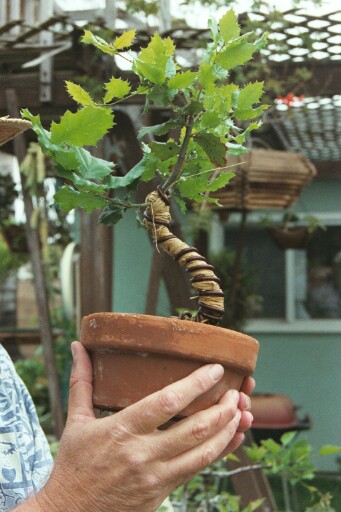
Figure 1: A small oak tree with the trunk bent using the
traditional raffia technique.
Nomenclature: I use a number of engineering terms here in what is essentially an engineering application to bonsai. Some bonsaists may not be familiar with these technical terms so I define them here first:
Note, then, that by these definitions, that wire on a branch generally will have both an axial and tangential component to its direction.
- axial Along the direction of the branch or trunk, sometimes also called "longitudinal."
- normal Direction perpendicular to a surface.
- radial Outward from direction of the trunk, normal to the bark.
- tangential Perpendicular to both the axial and radial directions; the direction around a trunk or branch is tangential.
One technique for bending curves in trunks (or heavy branches) is to wrap the trunk with wet raffia first. Binding the trunk with raffia keeps it from breaking so more severe bends can be formed. However, the raffia technique is difficult and time consuming. First an axial layer of wet raffia is applied. Then the trunk is wound with a tangential layer. Soaking, wrapping, and tying the raffia is troublesome, but works well when done properly. A tree bent with the raffia technique is shown below in Figure 1:

Raffia is a natural fiber used for making baskets and hats. Noted for its wet strength, raffia is obtained from the stalks and leaves of a Madagasdar palm. Raffia works well for strengthening trunks and branches for bending for bonsai, but is difficult to apply properly. It occurred to me that fiberglass strapping tape might afford the strength of wet raffia and the stickiness of the tape might make it easy to apply. I started my experiment with a rather straight and uninteresting valley oak I had grown from an acorn (Figure 2).
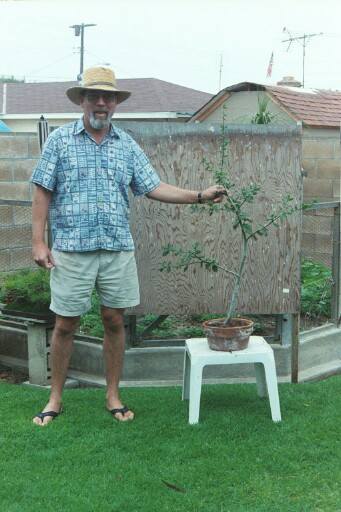
First I ran lengths of the inch-wide strapping tape up the trunk covering all sides (Figure 3). The axial layer adds longitudinal strength. This is what keeps the bark from rupturing during bending.
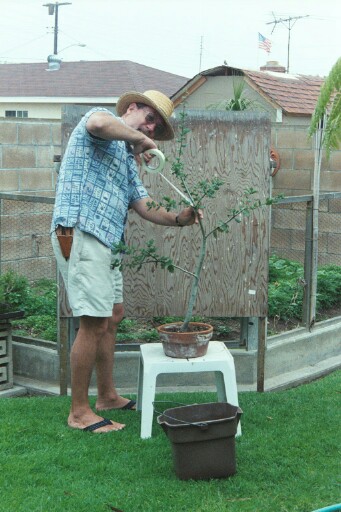
Next I wound a tangential ply layer around the trunk, winding it around and around. No need to stop and tie in more raffia! The tape roll holds many feet and the wrapping process goes quickly. I held the tape fairly tight as I wrapped (Figures 4-6).

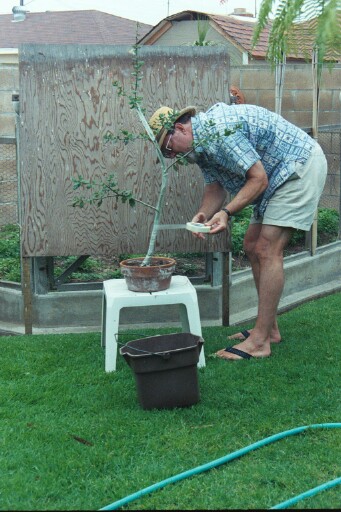

Next I wound the trunk with a thin aluminum wire. I am going to counterwind a slightly heavier wire tightly over that, and the first wire ensures that I will be easily able to pass a wire under the top wire for later tying.
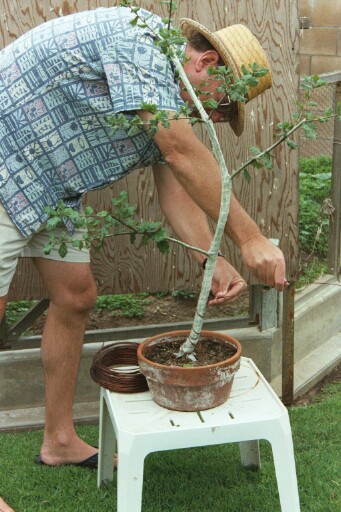
Then I counterwind a slightly heavier wire over the first wire. This deliberately violates the "no crossed wires" rule, but these wires are not holding wires, but provide tie points for tensile members (wire stays) to later hold the bent shape.
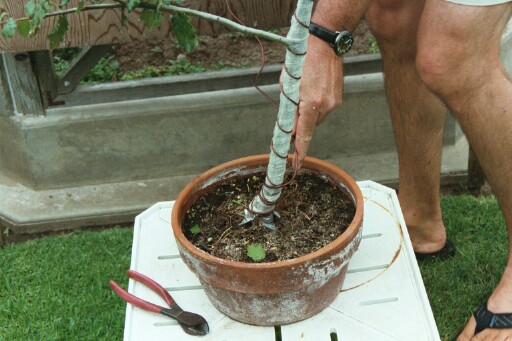
Finally, I start bending the trunk. Starting with the thickest part (base of the tree), I start making an S curve. This is the part where I needed a helper (not shown) who tied the wire stays while I held the bends.
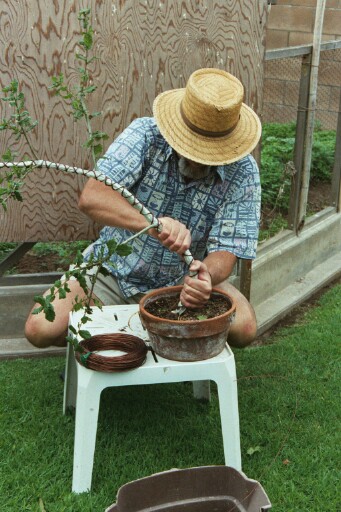
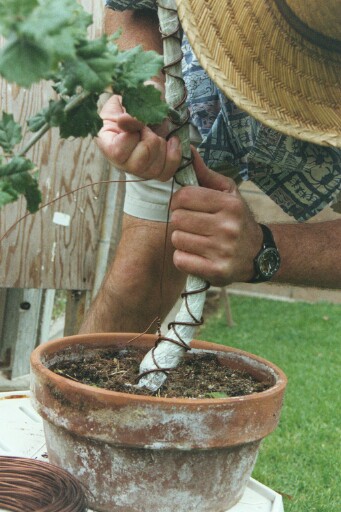
I formed the second bend so the branch was at the outside of the curve. The first bend stay had relaxed somewhat and would later be tightened to hold a more severe curve.
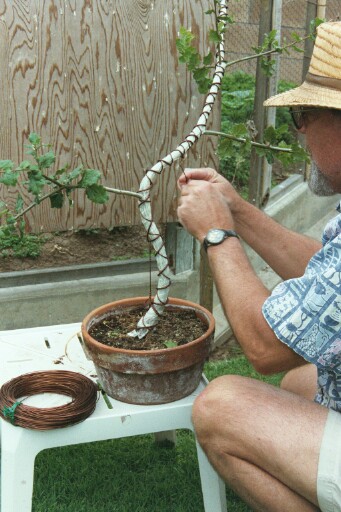
I continued the process with the third bend also having a branch on the outside (Figure 12).
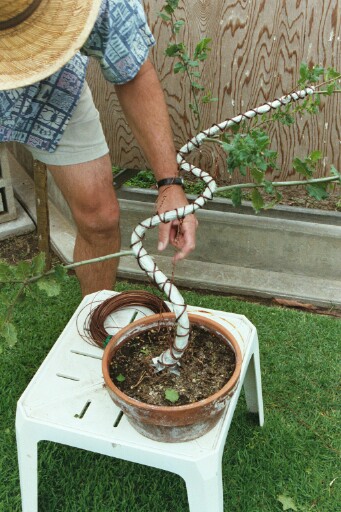
I repeated the S curve at the top of the tree where it was considerably easier to bend.
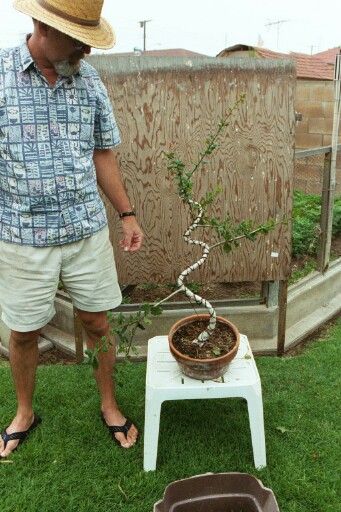
John Naka said in his Bonsai Techniques that a tree bent with a repetitious S curve like this one could be considered monotonous and therefore also uninteresting. I did the bending in this manner to illustrate a new techniqe. It is quite likely that the future tree will be shortened considerably, so that repetition might not be present in its future form.
I was quite pleased with the way the bending with strapping tape and wire stays came out. Raffia will disintegrate on its own over time, but the fibergalss will not. It has been about three months now (as of this writing) since the bending was done. The tree has new growth and shows no ill effects from the tape or the bending. Next spring I will remove the wire and tape and I hope to have photographs with which to update this article.
 Email Richard dot J dot Wagner at gmail dot com
Email Richard dot J dot Wagner at gmail dot com
This page created August 16, 2002, by Rick Wagner. Last updated June 10, 2013 by Rick Wagner.